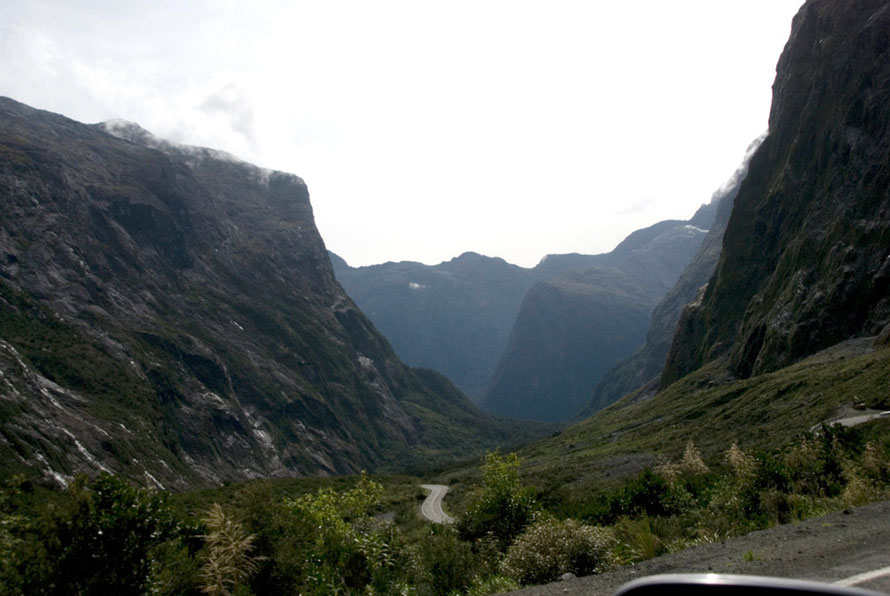IV. Some history of the Milford Road
In 1890, Robert West Holmes (1856 - 1936) carried out exploratory work in connection with the road later to be constructed to Milford Sound, through the Homer Saddle.
His wife accompanied him on this arduous tour, and the Gertrude Saddle was named after her. There is also a Gertrude Valley that joins the Milford Route from the north half a kilometre before the eastern entrance to the Homer Tunnel.

The Homer Tunnel
In 1935 five men with picks, shovels and wheelbarrows began the creation of a 1,240 metre long tunnel through the Darran Mountain Range towards the Cleddau Valley.
The conditions were harsh for Depression-era relief workers.
Starting at the eastern end a small tunnel was driven into the granitic rock at a falling 1:10 gradient. Fractures in the rock allowed the ingress of thousands of gallons of snow meltwater and compressors and a powerhouse in the nearby river were eventually built to pump out 40,000 litres of water per hour.
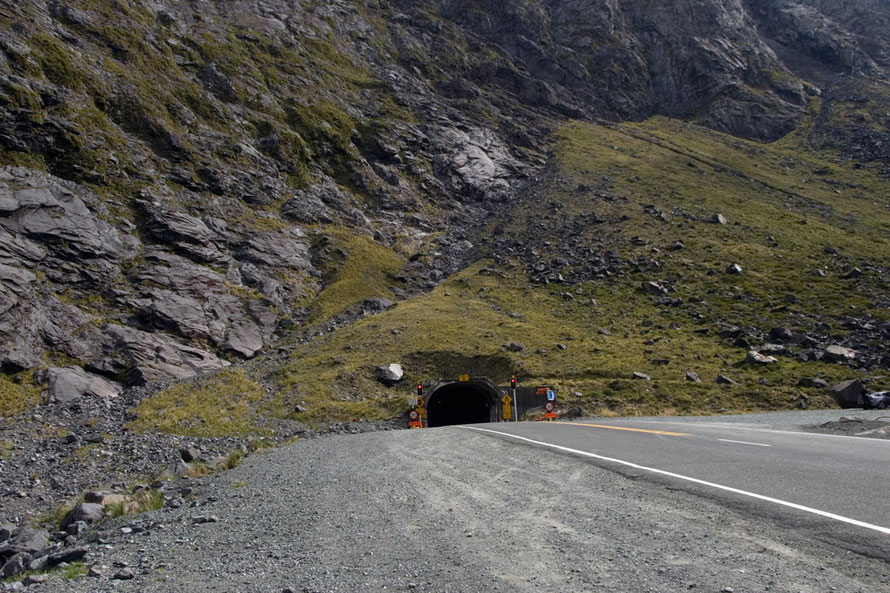

Avalanches were a constant danger in the winter. In July 1936 26 year old tunneller, Percy Leigh Overton, was killed and several men injured when an avalanche engulfed the tunnel’s entrance.
A reinforced concrete shelter was put up over the tunnel mouth to provide protection but in 1937 two more fatalities were caused by an avalanche. This time it got the Public Works Department Engineer-in-Charge, Donald Hulse and the tunnel works overseer, Thomas W. Smith.

The force of the dry, soundless avalanches dropping from the snow fields 800m up was enormous and in 1945 the reinforced concrete approach was destroyed by yet another avalanche.
It was not until February 1940 that the so-called ‘hole-through’ was accomplished. The tunnel still required widening to 5.5m by 7m, a task that was not completed until 1953.
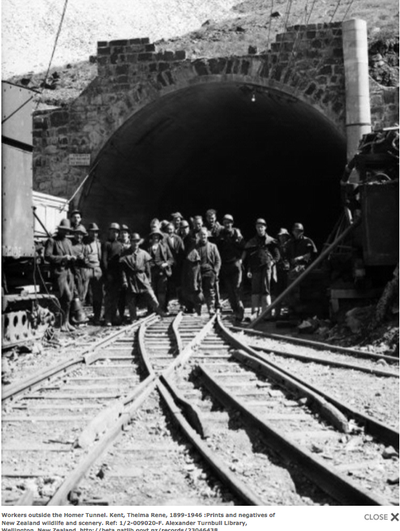
The tunnel is named after William Henry Homer (1838-1894). He and George Barber 'discovered' the Homer Saddle in 1889, and suggested the nearby road tunnel.
The tunnel and the Milford Road were gravel-surfaced until the 1980s (sources: IPENZ and Wikipedia).
In 2013 a complicated engineering project drilled and blasted out a 2,000 tonne rock pinnacle that stood over a thousand feet above the tunnel's western portal at the Moir's Mate Diamond Face.
The blast design ensured that the rock was blown into small fragments so that no massive boulders rained down over the temporary rockfall protection that had been built out from the tunnel portal (ACENZ 2014).
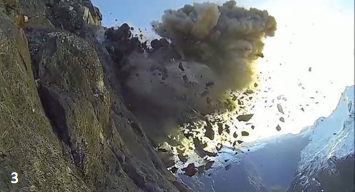
In April 2010 a violent weather front hit Southland causing extensive flooding. A massive – though not record-breaking – 300mm (12 inches) of rain fell in 24 hours near the Homer Tunnel on the Milford Road.
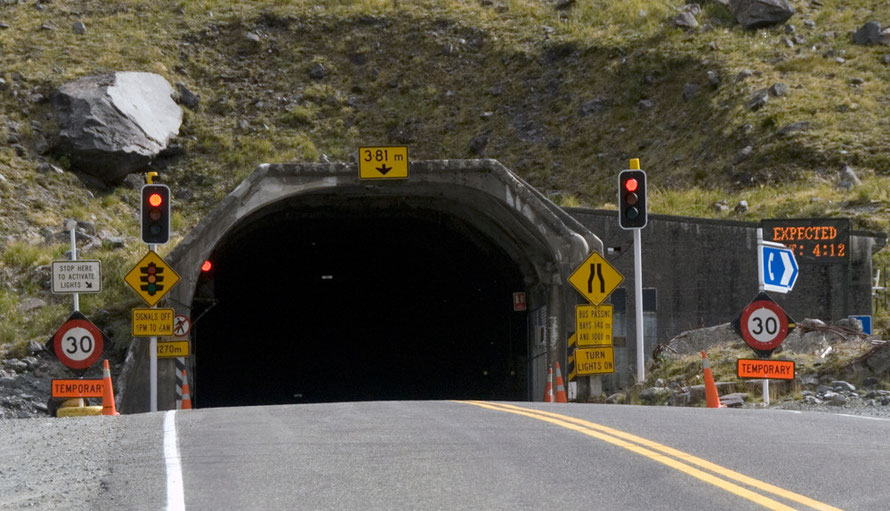
The Great Nude Tunnel Run is now an annual event through the Homer Tunnel. There are surprisingly few pictures of the event. As Rosco's Kayaks of Milford say,
'To travel through [the tunnel] fully clothed and in the comfort of a vehicle evokes enough horror – but running through it in the dark? Naked?'
But since 1988 100 or so hardy souls make the east-west traverse with only shoes and a torch. Roscos Kayaks have a fleeting photo.

The first members of the public to go through Homer Tunnel - a tale from 1953
This is personal correspondence I very gratefully received about the Milford Road. I've reproduced it in full. (The 'PWD' was the Public Works Department.)
'In 1953 (when the tunnel was opened only to Bus and PWD vehicles my Teachers' College Mate - Roy Williams [...] and I were on a bicycle trip from Dunedin to Milford Sound over gravel roads all the way but at Cascade Creek we were told we could not go through the tunnel on bikes as the public was not permitted.
But a guy [...] on the [eastern] side met us and said he would take us through in his one ton truck so we packed our bikes in the back (under the canopy) and he said just wait for a bit while I go into the Camp Store for provisions.
The "store" was also a sort of "Pub". But [our driver] spent about an hour and half drinking before he came out quite under the weather. We had second thoughts about his driving capabilities but nevertheless complied when he said, 'Hop in boys!'
Soon we were off to the tunnel - it was December 1953 about 7 pm and the sun was just going down. We had a lot of terrifying moments with [the] driving but that would take many words to go into details.
When we reached the Eastern Tunnel Portal [the driver] took us to have another "nightcap" with his mate at the tunnel PWD camp. His mate there told [him] that he was acting illegally by taking public people through tunnel in a PWD vehicle - strictly forbidden.
But we carried on anyway - more terrifying moments - when we got to the middle of the tunnel [the driver] switched off the lights and said,
"Well boys you are the very first two public kiwis through this tunnel apart from PWD workers!!!! How does that feel?"
We said very honoured but urged him to switch on the lights and get going again.
We negotiated passing a huge compressor in the middle of the road and finally came out on the western side (in pitch dark by now) [and the driver] was starting to drop his head and we were afraid he would drop off to sleep and we would drop off the road thousands of feet below.
When we came to the small narrow bridges (no railings) [he] stopped and said, "You boys will have to guide me over these bridges" - but he was too far left, or too far right and we were almost filling our pants. So I said,
"You need a sleep - I will take over the truck and Roy will be my guide."
He said, "You know how to drive a truck?"
I said "Yes - I have my heavy traffic licence - and my father has trucks contracted to PWD for road maintenance." (All true facts)
"OK," he says. I probably do need a bit of a nap.
So he sat in the middle with me the driver and Roy in the passenger's seat. We negotiated what seemed to be about a dozen or more narrow "bridges" and finally hit relatively flat land.
But the amazing thing is that about 2 minutes before we reached [the driver's] camp (Mt Tutuko Camp, I think) he woke up suddenly told us to stop and took over the driving again. Instinct I guess.
As I say there were lots of anxious moments - but this is just a small tale to say Roy Williams and Vic Lloyd were the first members of the public to go through the Homer Tunnel in 1953 before it officially opened in 1954.
A small historical record.'




